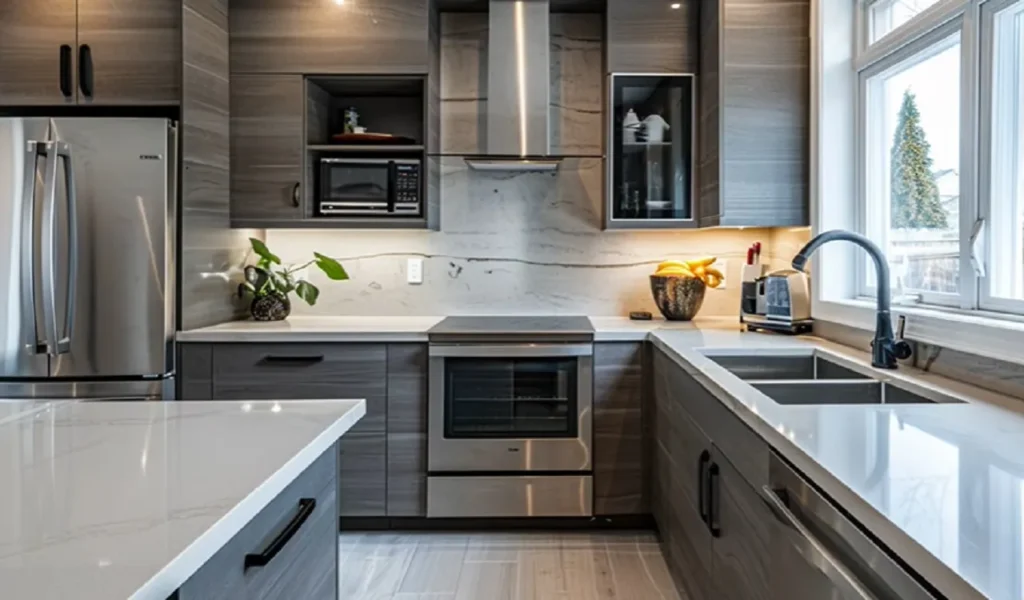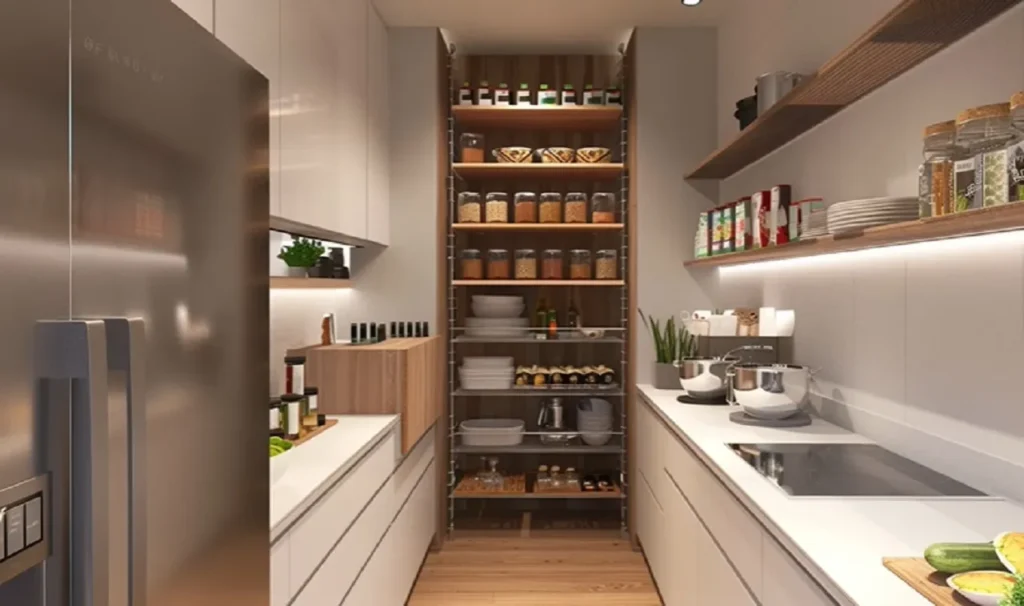Want to maximize space and style in your compact cooking area? This article explores layout hacks and clever kitchen storage solutions to help you design a small kitchen that’s both functional and aesthetically pleasing.
It can be challenging to design small kitchens in a way that maximizes both functionality and storage, while maintaining an aesthetically pleasing appearance. That is why the best ideas and inspirations to make the most of compact kitchen areas will be explored.
Efficient Layouts
If you’re designing a small kitchen, you need to prioritize an efficient layout. It is always best to try to work with the structures you have, as it is expensive to change pipes and wires. But if you do end up changing the layout, look into how you can maximize natural light, such as knocking down a wall or adding in more windows.
There’s quite a few layouts that you can choose from, but the most popular for small kitchens are single wall, galley, island kitchens, and L-shaped layouts.
Single Wall Kitchen
The single wall kitchen, also known as the straight or one wall kitchen, is when everything is put along one wall, including your appliances, cabinets, and countertops. They’re mostly seen in very small apartments and studios. When there’s an open plan living area, as they have a very streamline and unobtrusive appearance.
The main downside of this layout is that there’s often limited countertop space, and it can be difficult to implement an efficient work triangle.
Galley Kitchen
A galley layout kitchen has two parallel walls of cabinets and countertops with a walkway in between. It is a classic layout that is very functional and is perfect for long or narrow rooms.
They also tend to have more storage than other kitchen layouts because of the parallel walls. But you have to make sure these kitchens have proper ventilation, as cooking odors can linger in narrow spaces. You also have to ensure that there’s adequate lighting, as its layout can sometimes feel cramped.
Island Kitchen
In an open concept layout, an island portable kitchen is a great idea, as it will serve as a focal point and define the kitchen area while still maintaining an open seal. They’re also quite multi-functional, as an island can be used as a prep area, dining table, or homework station, which is perfect when you’re short on space.
However, if you do want an island, you really have to take into account space constraints. You need a minimum of 1 meter around the island, so that there is enough room to move around. If you don’t have enough space for that, but really need extra working space, it may be a better idea to get a small work bench or the portable option like a trolley work bench, and place a butcher block on top of it or even get a butcher trolley.
L-Shaped Kitchen
L-shaped kitchens are usually seen in medium to large spaces, but this layout can also be used in small spaces. The L-shape always makes good use of corners and can be fitted with specialized cabinets like Lazy Susans to maximize storage. It also supports an efficient work triangle and can accommodate multiple people working in the kitchen at once without getting in each other’s way.
The biggest downside is that countertop space can be limited when an L-shaped kitchen is scaled down for a small space.

Optimizing Space and Traffic Flow
Every inch counts in a small kitchen, and keeping the space clean and tidy can make a huge difference to how functional and enjoyable the space is.
Base Cabinet Drawers
When it comes to designing a small kitchen, or really a kitchen of any size, it is always better to have base kitchen cabinet drawers instead of cabinet doors. With cabinets, you tend to just have a big open space, but with drawers you can easily access the things you store at the back.
You also don’t have the space to stand back and access deep lower cabinets in smaller kitchens. The only exception here is under your kitchen sink, where a cupboard is by far the better choice because of all the plumbing. If possible, try to get quite a few different drawer heights, so you can store bulkier items like all your pots and small appliances.
Drawer systems like the Blum Tandem Box are great, as they offer full extension and soft close features, making it easy to access everything in your kitchen. Also consider getting toe kick drawers to maximize your storage space. They don’t have much depth, but you can store thin products that you don’t use too often like baking trays and cooling racks.
Kitchen Work Triangle
You have to put a lot of thought into traffic flow for small kitchens, as there’s such a limited footprint. Firstly, consider where you’re putting your appliances. People are usually situated where an appliance is. So it’s important to avoid placing all your appliances in the same area to prevent major flow issues.
Think about how your kitchen work triangle is going to be set up. If you haven’t heard of this before, placing your sink, stove, and fridge in a triangular layout optimizes kitchen efficiency and functionality, as it minimizes unnecessary movement. Each part should ideally be between 1.2 to 2.7 meters apart, so they’re not too close or too far away, and the sum of all three legs should be between 4 and 8 meters.
Having said that, the kitchen triangle should be used only as a guide, not a be all and end all approach, with the idea behind it being flow and efficiency. You also need to make sure you’re not placing any of these components in inconvenient spots.
If you’re right-handed, the stove should go in the left corner, and if you’re left-handed, the stove should go in the right corner. You also have to be mindful of your dishwasher placement. It is best to place them near the sink so you can easily rinse dishes. You also want to put your kitchen bin near the sink, so you can easily scrape food scraps before rinsing your plates and loading them into the dishwasher.
As for cabinetry, remember to have your upper cabinet doors split in half, otherwise they’ll be too wide and will impede traffic flow when open.
Lighting and Decluttering Tips
Artificial and Natural Lighting
Using recessed ceiling light is perfect for general kitchen lighting. You only need two or three of them in a really small kitchen. But be mindful of their placement if you’re using them as task lighting. Under-cabinet lights are a popular option for task lighting. They’re great for illuminating your countertops as upper cabinets can cast very harsh shadows onto your workspace and make it hard to see at night time.
Another way to incorporate task lighting is to install a wall sconce with a directional shade over a sink or food preparation area. If you have an island kitchen or even a galley kitchen, you may choose to install a pendant light as accent lighting. They make a great focal point above an island and add lots of visual interest, as there are plenty of sculptural findings on the market. Just make sure they’re not hung too low. You don’t want people hitting their heads on them, especially if they’re over an eating area. That’s why it should typically be at least 36 to 42 inches between the bottom of the light to your countertop.
As much as artificial lighting is important, maximizing any available natural light you have is arguably even more important. Consider installing a skylight or full length windows. If that is not possible, clean up your existing windows so more natural light streams in. Glossy finishes and mirrored backsplashes can also help, but that comes down to your preferred aesthetic.

Decluttering
Clutter always makes a small space feel smaller than it is, and countertop appliances are often the culprit in kitchens. That is why you should try to be frugal with your appliances. Go through everything you own and pick out only the essentials or non-negotiables. Then try and find a place in a cupboard or drawer so the rest can be hidden away. You really should only have things that you use every single day on your counters.
Alternatively, try to coordinate your small appliances, so they look cohesive instead of a bunch of random shapes and colors. It’s also suggested that you look for smaller size appliances. Majority of small spaces are located in the city with convenient access to grocery stores, so you likely won’t need as big of a fridge as a family of four who lives in suburban areas. Same goes with other appliances like dishwashers. Could you get maybe a half-size dishwasher? There’s single drawer dishwashers available, which are handy in small spaces.
Take your cupboards right up to the ceiling rather than stopping short and leaving a huge gap, as will only end up gathering dust or getting filled with random stuff that will only add to the feeling of there not being enough space to store everything.